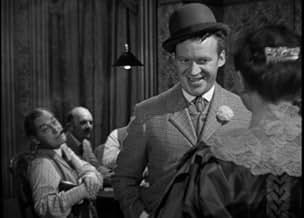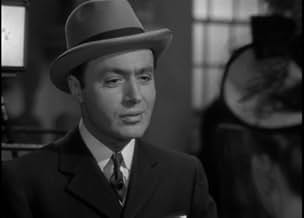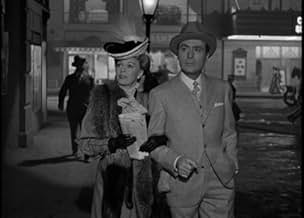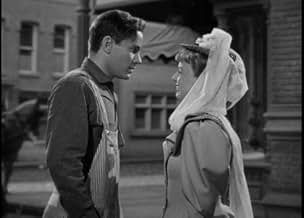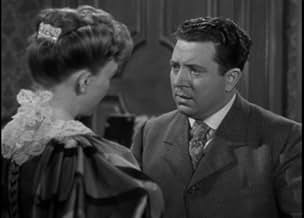CALIFICACIÓN DE IMDb
6.7/10
728
TU CALIFICACIÓN
Agrega una trama en tu idiomaFive years after meeting and falling in love with a banker, a willful shop girl decides to become his mistress upon learning he has since gotten married and had a son.Five years after meeting and falling in love with a banker, a willful shop girl decides to become his mistress upon learning he has since gotten married and had a son.Five years after meeting and falling in love with a banker, a willful shop girl decides to become his mistress upon learning he has since gotten married and had a son.
- Dirección
- Guionistas
- Elenco
- Nominado a 1 premio Óscar
- 3 premios ganados y 1 nominación en total
Eddie Acuff
- Andy
- (sin créditos)
Dorothy Adams
- Mrs. Brown
- (sin créditos)
William Alston
- Reporter
- (sin créditos)
- Dirección
- Guionistas
- Todo el elenco y el equipo
- Producción, taquilla y más en IMDbPro
Opiniones destacadas
This is the second of the thrice filmed Fanny Hurst novel about the other woman. Tastefully directed and lensed by Robert Stephenson and Charles Daniels and featuring standout performances from Charles Boyer and Margaret Sullavan it is probably the best of the bunch.
Traveling salesman Walter Saxel and free spirit Ray Smith meet through an acquaintance and in the course of an evening become strongly attracted to each other. He is engaged but makes a decision to marry her on board a river boat. She unfortunately misses the boat and Saxel doesn't see her for another five years marrying in the meantime. They rekindle and she becomes his mistress. As he grows in fame and fortune she remains in the shadow for decades until his children confront her.
Boyer and Sullavan as the long time lovers display a wonderful chemistry with each other. Sullavan's husky voice and Boyer's suave inflection reinforced by telling glances unite the two in an odd but perfect romantic match. Richard Carlson as a well intentioned suitor is also well cast and Frank McHugh, allowed to stretch, shines as Ray's loyal friend with an eternal crush.
Director Stephenson does an excellent job of keeping mood subdued without resorting to hysterics to bring life to the story. His adults behaving like adults expressing and suppressing their feelings in a tempered but passionate way gives the film a graceful tension. Cinematographer Charles Daniels turns in his usual array of impeccably lit compositions such as an evening snowfall where Ray and Walter meet for the first time in five years and the powerful final moments that he along with Stephens jarring and effectively de-romanticizes with stunning portraiture that evokes Goya.
Traveling salesman Walter Saxel and free spirit Ray Smith meet through an acquaintance and in the course of an evening become strongly attracted to each other. He is engaged but makes a decision to marry her on board a river boat. She unfortunately misses the boat and Saxel doesn't see her for another five years marrying in the meantime. They rekindle and she becomes his mistress. As he grows in fame and fortune she remains in the shadow for decades until his children confront her.
Boyer and Sullavan as the long time lovers display a wonderful chemistry with each other. Sullavan's husky voice and Boyer's suave inflection reinforced by telling glances unite the two in an odd but perfect romantic match. Richard Carlson as a well intentioned suitor is also well cast and Frank McHugh, allowed to stretch, shines as Ray's loyal friend with an eternal crush.
Director Stephenson does an excellent job of keeping mood subdued without resorting to hysterics to bring life to the story. His adults behaving like adults expressing and suppressing their feelings in a tempered but passionate way gives the film a graceful tension. Cinematographer Charles Daniels turns in his usual array of impeccably lit compositions such as an evening snowfall where Ray and Walter meet for the first time in five years and the powerful final moments that he along with Stephens jarring and effectively de-romanticizes with stunning portraiture that evokes Goya.
BACK STREET (Universal, 1941), directed by Robert Stevenson, is one of the finer love stories from the "soap opera" school that owes its success to the popular 1931 novel authored by Fannie Hurst. Initially produced by Universal in 1932 starring Irene Dunne and John Boles, this latest edition not only improves in style and performance from the earlier tearjerker, but simply indicates how "great movies are not made, they're remade." Usually whenever an original product gets redone, comparisons are usually made. There's no question that the Dunne and Boles romancer proved highly successful, but in contrast, this edition benefits greatly by its fine scripting by Bruce Manning and Felix Jackson, believable performances by Charles Boyer and Margaret Sullavan, and most of all, its impressive and sensitive scoring by Frank Skinner.
Following the same pattern to the original, with few alterations along the way, the story gets underway in "Cincinnati, at the turn of the century" where Ray Smith (Margaret Sullavan) parades down the street with Curt Stanton (Richard Carlson), owner of a bicycle shop who later becomes an automobile manufacturer in Michigan. While Curt loves Ray and hopes to marry her, she very much prefers her carefree lifestyle and the company of various male suitors, especially Eddie Porter (Frank McHugh), a traveling salesman. While Ray bids Eddie farewell at the train station, he introduces her to Walter Louis Saxel (Charles Boyer), a Louisiana Frenchman and prominent New York banker arriving on a short stay before leaving on the next ferryboat. Not only do Ray and Walter become better acquainted within a few hours, but fall deeply in love. Having remained in town longer than expected, Walter makes arrangements to leave. Before he does, he confesses his engagement to marry and that they will never see each other again. The following morning, however, Walter, who cannot forget Ray, telephones her to meet him at the dock. Before her arrival, Walter makes preparations for a surprise wedding that's to take place on the boat between him and Ray. As Ray closes shop to meet Walter, situations occur preventing her from arriving at all. By the time she does gets there, she finds Walter gone and the ferryboat slowly disappearing from view. Five years pass. Ray, now a clothing designer in New York City, meets Walter again, now a prominent banker. Regardless of Walter now a married man with a son, the couple find they cannot live without each other. For the next 25 years (with its final chapter set in 1928), Ray lives the "back street" of Walter's life, passing herself off to others as his wife, Mrs. Raymond Smith. Problems take its toll as the middle-aged Ray is confronted by Walter's two grown children (Tim Holt and Nell O'Day). Having known of their father's illicit affair, they make ever effort of doing something about it.
The basic premise to BACK STREET is "what if?" What if Ray were able to meet Walter at the dock and marry him as planned. Would their lives have been happier? Possibly so. Had it worked out that way, then there wouldn't have been the classic story of complications as we know it. Essentially a Sullavan film, it is Boyer whose name heads the cast of such notables as Esther Dale (Mrs. Smith, Ray's stepmother); Kitty O'Neil (Mrs. Dilling, the kindly landlady); Frank Jenks (Harry Niles); Samuel S. Hinds (Felix Darren); Nella Walker (Corinne Saxel, Walter's wife); Peggy Stewart (Freda, Ray's sister); Cecil Cunningham (Mrs. Miller) and Marjorie Gateson (Mrs. Adams). There's also surprise casting of cowboy actor Tim Holt playing Boyer's son, and a more or less straight performance by funster, Frank McHugh.
Boyer, the romantic, is no stranger to motion picture love stories, with LOVE AFFAIR (RKO Radio, 1939) opposite Irene Dunne, being one of his best portrayals. However, his Walter Saxel is less sympathetic due to his selfishness for keeping both wife and mistress, and the way he takes Ray for granted. One such scene is evident as Walter spends an entire summer vacationing in Europe with his wife, with Ray waiting alone in her apartment for his letters that never come. Upon his return, days after the boat docks, Walter, without considering Ray's feelings, presents the news he's a father again. Ray, on the other hand, is strong willed except when it comes to Walter. Comparing the climatic showdown between father and son in both 1932 and 1941 editions, the soft-spoken Boles, best suited for faithful husband roles, presents himself as weak while Boyer's strong voice and forceful manner, especially when telling his son to mind his own business, is truly felt. Irene Dunne (Ray Schmidt) and Margaret Sullavan (Ray Smith), two different screen personalities, form their own interpretation of the same heroine, which works well on both levels for their performances.
BACK STREET proved favorable viewing with its frequent TV broadcasts throughout much of the 1970s, especially on WOR, Channel 9's "Million Dollar Movie" in New York City. In an August 1975 showing, BACK STREET was given a special broadcast without commercial interruptions. Interestingly, however, only the third retelling of the story, the 1961 modern-dress/ Technicolor version starring Susan Hayward and John Gavin was made available onto home video in the 1990s. In 2011, both 1941 and 1961 versions to BACK STREET have become available on DVD package through Turner Home Entertainment. A pity there wasn't a triple feature using all three editions to the Fanny Hurst tearjerker. Cable television history to 1941's BACK STREET consisted that of American Movie Classics (1990-1998), sometimes on the double bill with the 1932 original, and Turner Classic Movie (TCM premiere July 19, 2001.) While Boyer and Sullavan worked together again, this time in a comedy titled APPOINTMENT FOR LOVE (Universal, 1941), it's this version of BACK STREET for which they will be remembered best. (***)
Following the same pattern to the original, with few alterations along the way, the story gets underway in "Cincinnati, at the turn of the century" where Ray Smith (Margaret Sullavan) parades down the street with Curt Stanton (Richard Carlson), owner of a bicycle shop who later becomes an automobile manufacturer in Michigan. While Curt loves Ray and hopes to marry her, she very much prefers her carefree lifestyle and the company of various male suitors, especially Eddie Porter (Frank McHugh), a traveling salesman. While Ray bids Eddie farewell at the train station, he introduces her to Walter Louis Saxel (Charles Boyer), a Louisiana Frenchman and prominent New York banker arriving on a short stay before leaving on the next ferryboat. Not only do Ray and Walter become better acquainted within a few hours, but fall deeply in love. Having remained in town longer than expected, Walter makes arrangements to leave. Before he does, he confesses his engagement to marry and that they will never see each other again. The following morning, however, Walter, who cannot forget Ray, telephones her to meet him at the dock. Before her arrival, Walter makes preparations for a surprise wedding that's to take place on the boat between him and Ray. As Ray closes shop to meet Walter, situations occur preventing her from arriving at all. By the time she does gets there, she finds Walter gone and the ferryboat slowly disappearing from view. Five years pass. Ray, now a clothing designer in New York City, meets Walter again, now a prominent banker. Regardless of Walter now a married man with a son, the couple find they cannot live without each other. For the next 25 years (with its final chapter set in 1928), Ray lives the "back street" of Walter's life, passing herself off to others as his wife, Mrs. Raymond Smith. Problems take its toll as the middle-aged Ray is confronted by Walter's two grown children (Tim Holt and Nell O'Day). Having known of their father's illicit affair, they make ever effort of doing something about it.
The basic premise to BACK STREET is "what if?" What if Ray were able to meet Walter at the dock and marry him as planned. Would their lives have been happier? Possibly so. Had it worked out that way, then there wouldn't have been the classic story of complications as we know it. Essentially a Sullavan film, it is Boyer whose name heads the cast of such notables as Esther Dale (Mrs. Smith, Ray's stepmother); Kitty O'Neil (Mrs. Dilling, the kindly landlady); Frank Jenks (Harry Niles); Samuel S. Hinds (Felix Darren); Nella Walker (Corinne Saxel, Walter's wife); Peggy Stewart (Freda, Ray's sister); Cecil Cunningham (Mrs. Miller) and Marjorie Gateson (Mrs. Adams). There's also surprise casting of cowboy actor Tim Holt playing Boyer's son, and a more or less straight performance by funster, Frank McHugh.
Boyer, the romantic, is no stranger to motion picture love stories, with LOVE AFFAIR (RKO Radio, 1939) opposite Irene Dunne, being one of his best portrayals. However, his Walter Saxel is less sympathetic due to his selfishness for keeping both wife and mistress, and the way he takes Ray for granted. One such scene is evident as Walter spends an entire summer vacationing in Europe with his wife, with Ray waiting alone in her apartment for his letters that never come. Upon his return, days after the boat docks, Walter, without considering Ray's feelings, presents the news he's a father again. Ray, on the other hand, is strong willed except when it comes to Walter. Comparing the climatic showdown between father and son in both 1932 and 1941 editions, the soft-spoken Boles, best suited for faithful husband roles, presents himself as weak while Boyer's strong voice and forceful manner, especially when telling his son to mind his own business, is truly felt. Irene Dunne (Ray Schmidt) and Margaret Sullavan (Ray Smith), two different screen personalities, form their own interpretation of the same heroine, which works well on both levels for their performances.
BACK STREET proved favorable viewing with its frequent TV broadcasts throughout much of the 1970s, especially on WOR, Channel 9's "Million Dollar Movie" in New York City. In an August 1975 showing, BACK STREET was given a special broadcast without commercial interruptions. Interestingly, however, only the third retelling of the story, the 1961 modern-dress/ Technicolor version starring Susan Hayward and John Gavin was made available onto home video in the 1990s. In 2011, both 1941 and 1961 versions to BACK STREET have become available on DVD package through Turner Home Entertainment. A pity there wasn't a triple feature using all three editions to the Fanny Hurst tearjerker. Cable television history to 1941's BACK STREET consisted that of American Movie Classics (1990-1998), sometimes on the double bill with the 1932 original, and Turner Classic Movie (TCM premiere July 19, 2001.) While Boyer and Sullavan worked together again, this time in a comedy titled APPOINTMENT FOR LOVE (Universal, 1941), it's this version of BACK STREET for which they will be remembered best. (***)
Two of Hollywood's greatest actors, Charles Boyer and Margaret Sullavan, starred in this first remake of the 30s tearjerker, and they
portrayed the star-crossed lovers with great restraint. Acting, writing and direction all combined to create the ultimate BACK STREET! Warners had their crime dramas, MGM had their musicals, Paramount had their comedies, and Universal had the best weepers. This may be the very best one ever! Even the supporting cast was hand-picked with care. Richard Carlson, ever the "other guy", does his thing once more, and we want him to win for a change, but in this case, true love ruins all. Frank McHugh, as Rae's friend, gives perhaps his best performance.
portrayed the star-crossed lovers with great restraint. Acting, writing and direction all combined to create the ultimate BACK STREET! Warners had their crime dramas, MGM had their musicals, Paramount had their comedies, and Universal had the best weepers. This may be the very best one ever! Even the supporting cast was hand-picked with care. Richard Carlson, ever the "other guy", does his thing once more, and we want him to win for a change, but in this case, true love ruins all. Frank McHugh, as Rae's friend, gives perhaps his best performance.
Margaret Sullavan is one of my all-time favorite actresses with her husky voice and haunting screen presence. The original version in 1932 with Irene Dunne and John Boles was dull and stage-bound; the later version with Susan Hayward was just too gaudy. This is the version to watch!
Margaret gives an exquisitely heart-rending performance as a turn-of-the-century miss who falls in love with a man (played by the smooth but oh-so-serious Charles Boyer). Fate intervenes and the two lovers are separated. They meet again years later, but, true to the classic weeper formula, he is married. Despite her better judgment, she carries on a "Back Street" romance with him for many years until their untimely demises.
Promoted with the tag line, "If you have tears, be prepared to shed them", this movie does involve some suspension of disbelief. For example, for such a level-headed gal, why does Margaret allow Boyer to treat her so shabbily? Just when I am about to shake my head and yell "Why?", Margaret then either let loose with the tears or try to hide the choking sob in her voice, and I'm transfixed all over again.
This film does feature solid direction, beautiful photography and some good supporting performances (I particularly liked Frank McHugh in this one). This film remains on my "Wish-They-Release-This-One-on-Video" list.
Margaret gives an exquisitely heart-rending performance as a turn-of-the-century miss who falls in love with a man (played by the smooth but oh-so-serious Charles Boyer). Fate intervenes and the two lovers are separated. They meet again years later, but, true to the classic weeper formula, he is married. Despite her better judgment, she carries on a "Back Street" romance with him for many years until their untimely demises.
Promoted with the tag line, "If you have tears, be prepared to shed them", this movie does involve some suspension of disbelief. For example, for such a level-headed gal, why does Margaret allow Boyer to treat her so shabbily? Just when I am about to shake my head and yell "Why?", Margaret then either let loose with the tears or try to hide the choking sob in her voice, and I'm transfixed all over again.
This film does feature solid direction, beautiful photography and some good supporting performances (I particularly liked Frank McHugh in this one). This film remains on my "Wish-They-Release-This-One-on-Video" list.
Three great actresses, each in turn, Irene Dunne in 1931, Margaret Sullavan ten years later and Susan Hayward twenty years after that, took a shot at the role of Rae Smith, the protagonist of Fanny Hurst's popular novel "Back Street." Each tried her best to make sense of a perplexing character. Of the three actresses, Margaret Sullavan comes closest to putting it across. It's almost not fair to include Susan Hayward in the trio because for her the role was drastically rewritten. The others play more faithful versions. Rae Smith is a - I was about to say unique, but I cannot claim an encyclopedic literary knowledge - let us say, rare character. Scandalizing women abound in literature and film. None (at least I can't come up with any) are quite like Rae Smith. She is not a coquette like Manon, or a professional courtesan like Nana. She's not a poor girl seduced by the deviltry of a powerful man, like Faust's Margaret. She's not a conniver like Becky Sharp. She doesn't latch on to an otherwise intelligent man to destroy him, as Marlene Dietrich's Lola Lola in "The Blue Angel," or Arletty's Garance in "Les Enfants du Paradis," or Bette Davis' Mildred in "Of Human Bondage." She is a pure American type: an otherwise intelligent woman who lets a destructive man latch on to her. She ruins her life for love of a man who does not ruin his life for love of her. By the time Susan Hayward's turn came around that idea had become too grating. The story was twisted 180 degrees. Her Rae Smith refuses to surrender her life or her career for her man. He ruins his respectability, and loses his life, for her. That leaves Irene Dunne and Margaret Sullavan. Neither benefited from an indulgent screenplay. They had to struggle with the schizophrenia of their character. Rae is clearly possessed of a gifted and independent spirit. She blazes her way in a male-dominated world. Then she squelches that spirit, renounces her freedom, sacrifices all to the tedium of being a kept woman.
Why? Why does Rae efface herself, consent to live a life of clandestinity, no career, no children, no family, no friends except the man who enters, occasionally, for his pleasure? Margaret Sullavan comes closest to making sense of it all. She had an incomparable asset. Only one thing can plausibly account for Rae's self-destructive obsession. Only one thing can make her, every time she tries to break clear, act like a ball on a rubber string and bounce back to the stick that hits her. The man at the other end of the string must be a supremely attractive force. Irene Dunne had John Boles. He was a good actor and attractive in his way. (I, if I had been the casting director, would have switched him out for George Meeker who played against type as the goofy boyfriend Kurt.) Susan Hayward had John Gavin; we won't go there. Margaret Sullavan had Charles Boyer. Nobody among Hollywood's leading men could be more exotically romantic. Nobody could be more insidiously romantic. His ingratiating manner, his voice with its whiff of the foreign, easily projected a fatal attraction. It could hold in thrall otherwise strong-willed heroines: Ingrid Bergman in "Gaslight," Bette Davis in "All This and Heaven Too," Olivia de Havilland in "Hold Back the Dawn." I'm sure Margaret Sullavan saw that quality. Reportedly, she was so eager to have Boyer play opposite her in "Back Street" that she willingly yielded him the top billing. She was wise. Walter Saxel is a cad. He must be a mesmerizing cad, to imprison her, to hold her believably under his spell. Nobody could make a cad hypnotic better than Charles Boyer. Nobody could play a tormented heroine ("Three Comrades," "Cry Havoc") better than Margaret Sullavan (except perhaps Ida Lupino). She turns it on here full force, in her desperate look as she watches the steamboat carry Walter away up the Ohio, in her frantic reaction when she's hijacked by Frank Jenks' loathsome lothario, in her forlorn features as she sits in her paid-for hotel room after Walter's calamitous demise. Put that pair together before the camera, have them sit against a haystack and talk about the clouds. It makes even a story like "Back Street" work. It is unashamedly a tearjerker. It grates against modern sensibilities. But the chemistry of Sullavan and Boyer lifts it, though it takes some effort, past those liabilities. "Back Street" is worth a look for two great actors at their peak. If only Rae hadn't missed that steamboat ...
Why? Why does Rae efface herself, consent to live a life of clandestinity, no career, no children, no family, no friends except the man who enters, occasionally, for his pleasure? Margaret Sullavan comes closest to making sense of it all. She had an incomparable asset. Only one thing can plausibly account for Rae's self-destructive obsession. Only one thing can make her, every time she tries to break clear, act like a ball on a rubber string and bounce back to the stick that hits her. The man at the other end of the string must be a supremely attractive force. Irene Dunne had John Boles. He was a good actor and attractive in his way. (I, if I had been the casting director, would have switched him out for George Meeker who played against type as the goofy boyfriend Kurt.) Susan Hayward had John Gavin; we won't go there. Margaret Sullavan had Charles Boyer. Nobody among Hollywood's leading men could be more exotically romantic. Nobody could be more insidiously romantic. His ingratiating manner, his voice with its whiff of the foreign, easily projected a fatal attraction. It could hold in thrall otherwise strong-willed heroines: Ingrid Bergman in "Gaslight," Bette Davis in "All This and Heaven Too," Olivia de Havilland in "Hold Back the Dawn." I'm sure Margaret Sullavan saw that quality. Reportedly, she was so eager to have Boyer play opposite her in "Back Street" that she willingly yielded him the top billing. She was wise. Walter Saxel is a cad. He must be a mesmerizing cad, to imprison her, to hold her believably under his spell. Nobody could make a cad hypnotic better than Charles Boyer. Nobody could play a tormented heroine ("Three Comrades," "Cry Havoc") better than Margaret Sullavan (except perhaps Ida Lupino). She turns it on here full force, in her desperate look as she watches the steamboat carry Walter away up the Ohio, in her frantic reaction when she's hijacked by Frank Jenks' loathsome lothario, in her forlorn features as she sits in her paid-for hotel room after Walter's calamitous demise. Put that pair together before the camera, have them sit against a haystack and talk about the clouds. It makes even a story like "Back Street" work. It is unashamedly a tearjerker. It grates against modern sensibilities. But the chemistry of Sullavan and Boyer lifts it, though it takes some effort, past those liabilities. "Back Street" is worth a look for two great actors at their peak. If only Rae hadn't missed that steamboat ...
¿Sabías que…?
- TriviaA contemporary article in the Los Angeles Examiner stated Joan Fontaine was originally cast in the female lead, but she was replaced by Margaret Sullavan before shooting began.
- ErroresIn the closing sequences, which are supposed to be taking place in 1928, all of the women's hair styles and clothes, particularly those of Nell O'Day, and especially Margaret Sullavan's square-shouldered fur cape, are strictly contemporary 1941.
- ConexionesFeatured in The Universal Story (1996)
- Bandas sonorasAuld Lang Syne
(uncredited)
Traditional Scottish music
Lyrics by Robert Burns
Sung by New Year's Eve party revellers
Selecciones populares
Inicia sesión para calificar y agrega a la lista de videos para obtener recomendaciones personalizadas
- How long is Back Street?Con tecnología de Alexa
Detalles
- Fecha de lanzamiento
- País de origen
- Idioma
- También se conoce como
- Back Street
- Locaciones de filmación
- Productora
- Ver más créditos de la compañía en IMDbPro
- Tiempo de ejecución1 hora 29 minutos
- Color
- Relación de aspecto
- 1.37 : 1
Contribuir a esta página
Sugiere una edición o agrega el contenido que falta


